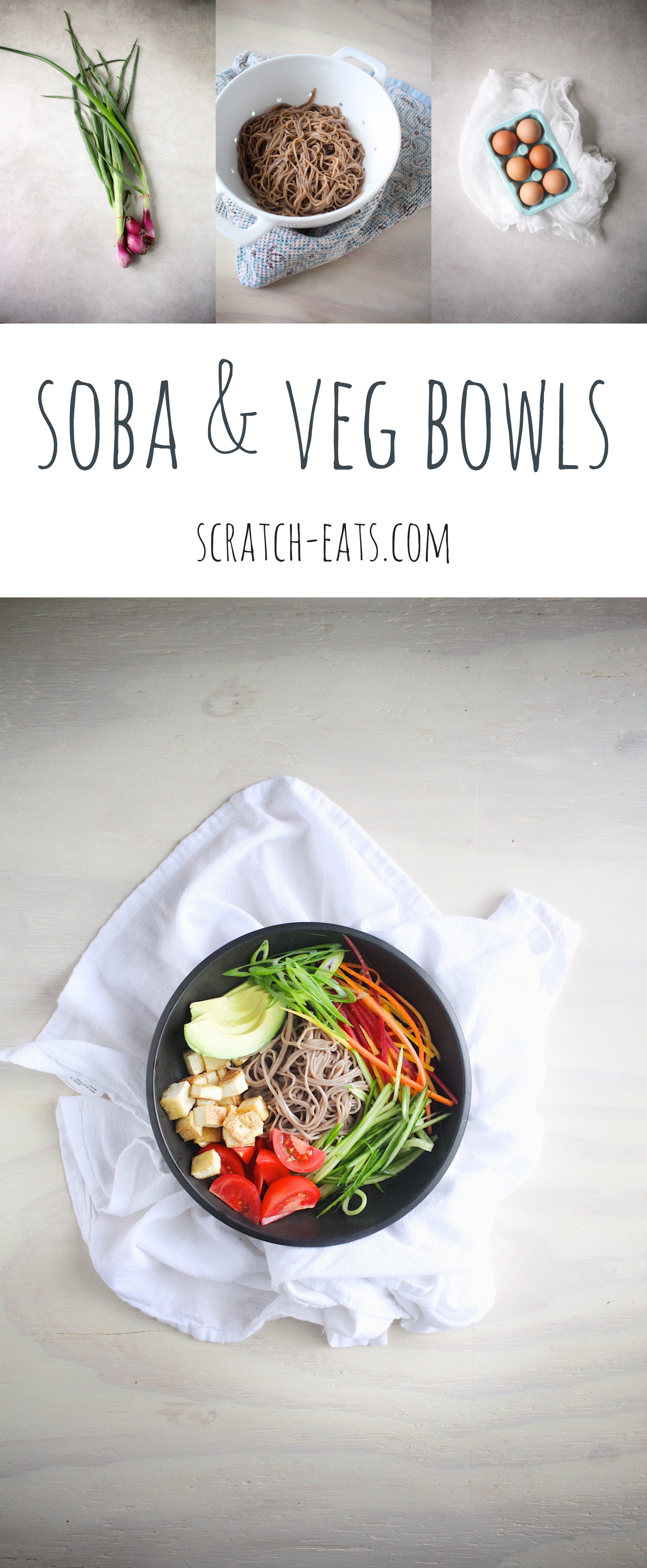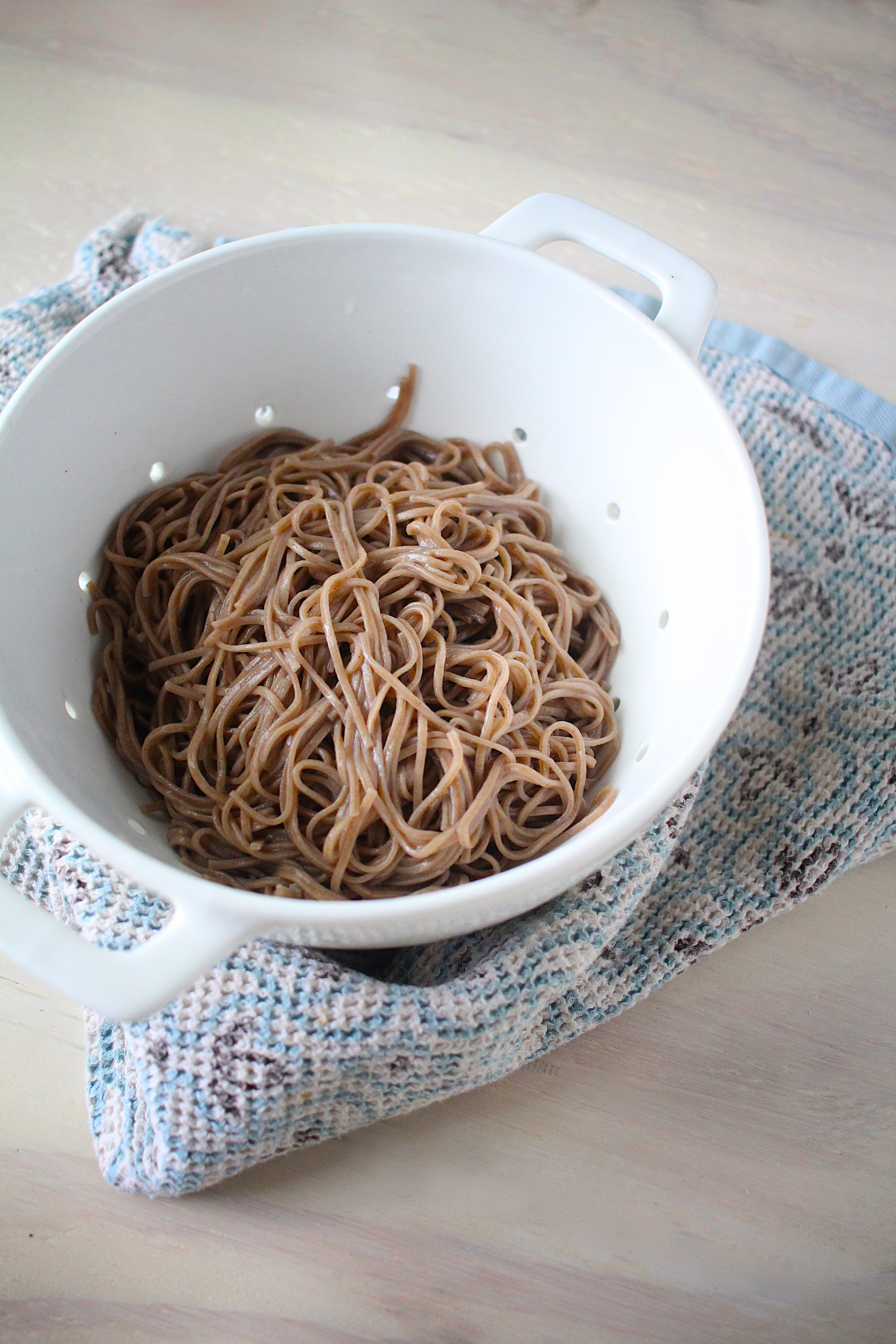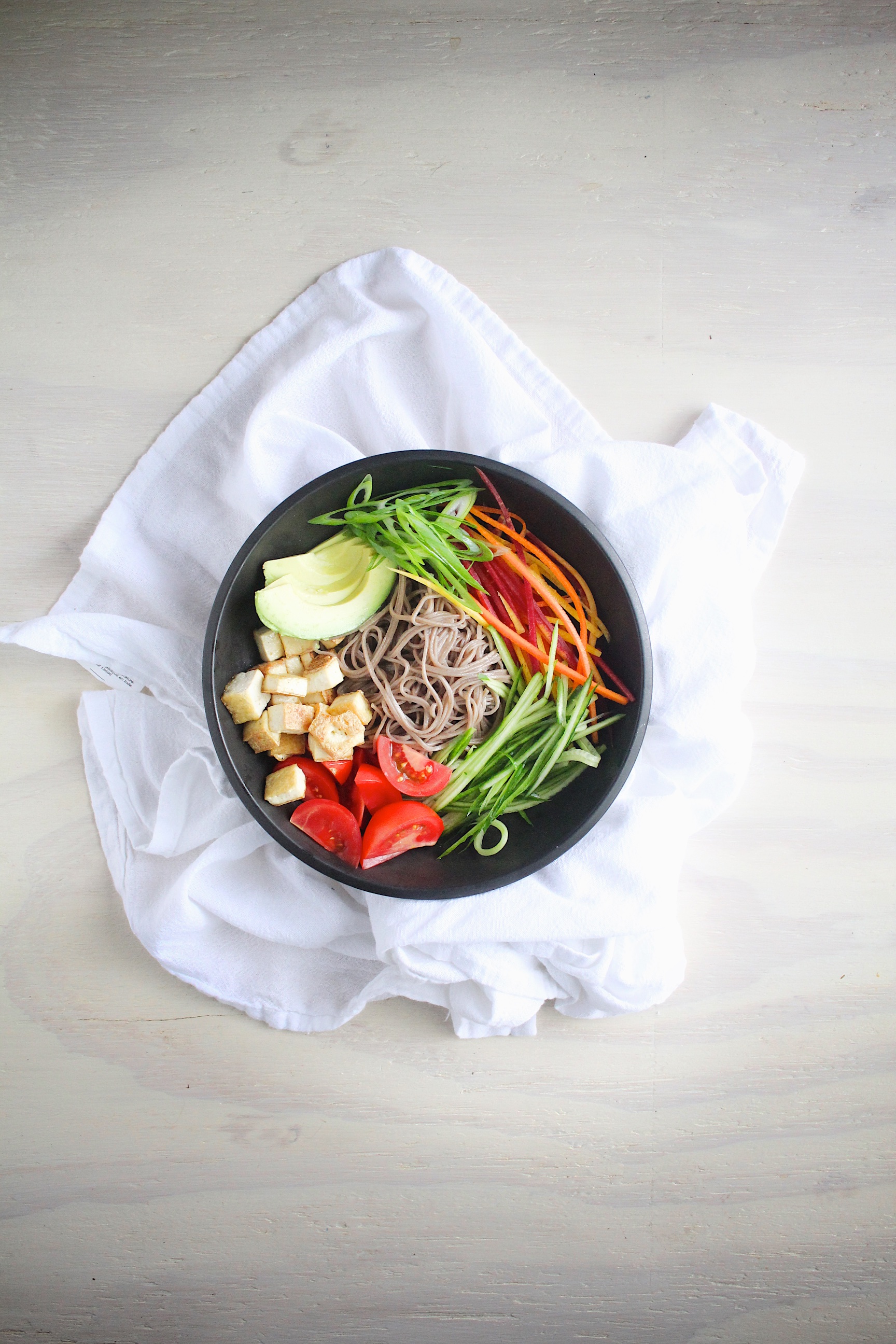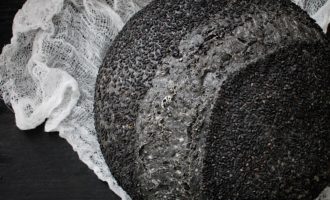Soba and Vegetable bowls (vegetarian/vegan variations)
Soba cooks quickly, is nourishing, and pairs perfectly with almost any vegetable. And with a great Japanese-inspired sauce to go over it, these soba and vegetable bowls are irresistible.

Has Summer arrived where you are yet? Here in the Midwest, we’ve had some serious muggy weather these last few days, and it’s made me crave my childhood Summer staples. One dish my mom always made was this soba bowl packed full of texture- and flavor-varied vegetables and a really basic Japanese cold-noodle sauce called tsuyu. Tsuyu is used with all sorts of noodles. It varies a little depending on the type of noodle you use, and with soba you tend to go a little less sweet. It’s usually made with a combination of dashi (Japanese stock), soy sauce, and mirin (Japanese sweet sake). Unfortunately, here in the U.S., mirin is not well regulated, and is often made with high fructose corn syrup and is just a glorified simple syrup with a tiny bit of alcohol added. Since I avoid processed foods and alcohol in general, my version is a little different. It’s going to sound a little crazy, but I use pure maple syrup instead. It somehow has a similar slightly musty aftertaste, and though they aren’t perfectly interchangeable, it works really well in this case.

The beautiful thing about this recipe is that you can really use whatever vegetables you have. It’s a cold noodle “salad”, so I’d recommend sticking to seasonal vegetables during Spring-early Autumn, but if you have a hankering for something cold mid-Winter, it would still be delicious with shaved cabbage of any variety, roasted sweet potatoes or sweet Winter squash, even cauliflower or broccoli. Yum! But today I’m going to share with you how I eat it in the Summer. And my vegetables of choice are tomatoes, cucumber, avocado, carrots, and green onions. The tomatoes are perfectly sweet and tart, and soft with a juicy pop while the cucumbers and carrots add different kinds of crunch and the avocados … oh don’t even get me started on the creamy perfection. And green onions, you just can’t skip them. That mild zingy onion bite completes the dish. And I like to julienne the carrots and cucumber (or cut them with a spiralizer), so it feels more like you’re adding levels of texture to the noodles. It’s fantastic, really.

And it’s so pretty! For the protein, I usually stick with either crispy tofu for a vegan friendly version (remember with any soy products, to use non-GMO verified and USDA certified organic) or egg ribbons, which I’ll explain how to do on the recipe card. Either way you try it, you win.
Happy eating!


- 1 package (roughly 9 ounces, depending on brand) dried soba noodles
- 2~3 medium carrots, peeled and julienned or cut with a spiralizer on the angel hair blade
- 2~3 medium thin-skinned cucumber (such as Japanese or Armenian cucumber), julienned or cut with a spiralizer on the spaghetti blade
- 1/2 pound tomatoes*, cut into bite-sized pieces
- 1 green onion, sliced very thinly on the bias
- 2 avocado, peeled and sliced thinly
- 1 package (roughly 14 ounces) firm or extra firm tofu, drained
- 4 large eggs**
- 1 cup dashi, chilled
- 2 tablespoons pure maple syrup
- 1/4 cup soy sauce
- In a 2 cup or larger liquid measuring cup, combine the tsuyu ingredients and place in the refrigerator to chill.
- If using the tofu, place a clean kitchen towel folded to roughly the size of the block of tofu on a plate or cutting board, and place the tofu on top. Then place another clean kitchen towel over it, another cutting board or plate, and weigh it down with something heavy, such as a jar of dried beans or a can of tomatoes, for about 15 minutes. Once pressed, cut the tofu into bite sized squares. Heat a nonstick skillet to medium-high with a little bit of oil, add the tofu, season with a pinch of salt, and sauté until all sides are golden brown and crispy. Set aside.
- If using the eggs, gently whisk the eggs with a fork in a small bowl with a pinch of salt. Heat a nonstick skillet over medium heat, with a very small amount of oil, about 1/2 teaspoon. Swirl the pan to coat the oil. Pour in about half of the eggs, just enough to cover the surface of the pan, swirl to coat and cover with a lid for 2 minutes. Remove the lid. If your egg was thin enough, it should be mostly set. Using a toothpick or skewer, loosen the egg from the sides of the pan, and flip it over. You can do this by place a plate about the same size as the cooking surface of the skillet on top of the egg, then pressing the plate into the pan, carefully flipping it over. Once the egg is on the plate you can carefully slide it back onto the skillet, fully cooked side up. Finish cooking until eggs are completely set, and flip onto a cutting board. Repeat with remaining eggs. Let the egg "pancakes" cool slightly. Cut them in half, and stack all of the halves on top of one another, and slice thinly width-wise. Set aside.
- Cook the soba in boiling water for 4-5 minutes until softened, then drain and rinse under cool running water. Unlike Italian pasta, with soba you want to wash off excess surface starch. Set aside.
- To assemble each bowl, place a portion of the soba in the middle, and arrange the other toppings around it in a circle. Pour equal portions of the tsuyu over the bowls and serve immediately.
- *When available, using heirloom tomatoes is best. If that's not a possibility, I prefer campari tomatoes, which are the only grocery store tomatoes I buy.
- **I would use the tofu or the eggs, not both. And when purchasing tofu, look for non-GMO verified and USDA certified. And when possible, go one step further and purchase sprouted tofu, as the sprouting process significantly reduces phytic acid and other anit-nutrients.
or for gluten-free soba, I like these:
King Soba Gluten Free, Organic 100% Buckwheat Pasta Noodles
Kikkoman imported organic soy sauce




Be the first to comment.